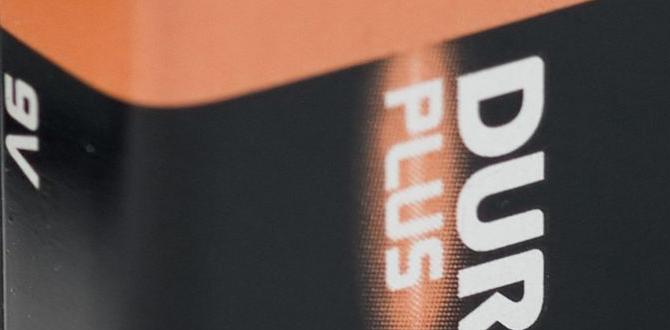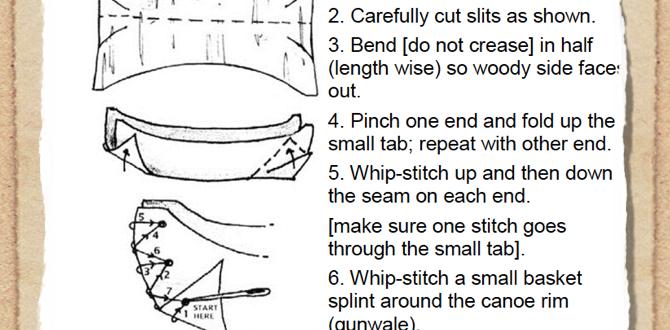The best cordless pin nailer for fine woodworking offers the ultimate blend of power, precision, and portability, allowing for nearly invisible fastening on delicate projects without the hassle of cords or compressors.
Hey there, fellow maker! Are you tired of tiny brads popping out or leaving frustrating marks on your beautiful woodworking projects? It’s a common worry, especially when you’re aiming for that flawless, professional finish. The good news is, you don’t need to be a seasoned pro to achieve it. A good cordless pin nailer can be your secret weapon for detailed work. This guide is here to walk you through everything you need to know to find the perfect one for your bench. Let’s get those projects looking amazing!
Table of Contents
Why a Cordless Pin Nailer is a Woodworker’s Best Friend
If you’ve ever worked with small, delicate pieces of wood, like intricate trim, crown molding, or even detailed picture frames, you’ve probably encountered the challenge of fastening them securely without leaving unsightly marks. Traditional nail guns can be overkill, leaving holes that are too large and difficult to hide. That’s where the magic of a pin nailer comes in.
A pin nailer drives incredibly thin nails, often called pins, that are virtually invisible once inserted. The heads are so small they often don’t even break the surface of the wood, meaning you can skip the tedious filling and sanding most of the time.
The Cordless Revolution
Now, imagine doing all that delicate work without being tethered to an air compressor or tangled in power cords. That’s the game-changer that cordless pin nailers offer. Battery-powered convenience means you can take your pin nailer anywhere – from a cramped workshop corner to a client’s home, or even outdoors. This freedom not only makes your work easier but opens up a world of project possibilities.
Choosing Your “Best Cordless Pin Nailer for Fine Woodworking”
When sorting through the options for the “best cordless pin nailer for fine woodworking,” a few key features will make a big difference in your day-to-day use and project results. We’re looking for precision, power, and ease of use.
What to Look For in a Cordless Pin Nailer:
Nail Size Compatibility: Most pin nailers fire headless nails ranging from 5/8 inch up to 2 inches. For fine woodworking, you’ll likely be using shorter pins (under 1.5 inches) most often. Ensure the nailer you choose can handle these smaller sizes reliably.
Depth Adjustment: Being able to control how deep the pin is driven is crucial. Too deep, and you might split delicate wood. Too shallow, and the pin won’t hold. Look for a tool with an easy-to-use depth adjustment dial or lever.
Contact Trip or Sequential Trip:
Contact Trip (Bump Fire): Allows you to fire nails rapidly by pressing the nose against the workpiece and squeezing the trigger. Great for speed.
Sequential Trip: Requires you to set the nose on the wood and then pull the trigger for each nail. Offers more precision, which is vital for fine woodworking. Many models offer a selectable trigger for both modes.
Jam Clearing: No one likes dealing with jammed nails. A tool with a tool-less jam clearing mechanism will save you precious time and frustration.
Ergonomics and Weight: Since you might be holding this tool for extended periods, a comfortable grip and balanced weight are important to minimize fatigue.
Battery System: If you already own other cordless tools from a particular brand, sticking with that brand’s battery ecosystem can save you money and avoid managing multiple chargers.
Power Source: Cordless pin nailers are battery-powered. Consider the battery voltage (18V is common and usually sufficient) and the run-time you can expect on a single charge.
Top Contenders for the Best Cordless Pin Nailer for Fine Woodworking
While the “best” tool is subjective and depends on your specific needs and budget, several brands consistently earn high marks from woodworkers for their cordless pin nailers. We’ll highlight a few popular and well-regarded options.
Here’s a look at some leading models that are frequently cited for their performance in fine woodworking applications:
| Brand & Model | Nail Range (Gauge/Length) | Key Features | Pros | Cons |
|---|---|---|---|---|
| Metabo HPT NP18DSLQ4 (formerly Hitachi) | 23 Gauge / 5/8″ – 1-3/16″ | Pneumatic-like feel, dry-fire lockout, belt hook, lightweight | Excellent for ultra-thin materials, minimal marring, great battery life | Limited nail length, can be pricier |
| DEWALT 20V MAX XR Pin Nailer (DCN693) | 23 Gauge / 5/8″ – 1-1/2″ | Dual-action trigger, tool-free depth adjustment, integrated belt hook | Powerful for its size, reliable performance, part of a vast battery system | Slightly heavier than some competitors |
| Milwaukee M12 FUEL Pin Nailer (2540-20) | 23 Gauge / 5/8″ – 1-3/8″ | Compact and lightweight, consistent depth, excellent for tight spaces | Very user-friendly, great for intricate work, minimal recoil | Battery life can be less than 18V systems for very long projects |
| Ryobi ONE+ 18V Cordless (Multiple models exist) | 23 Gauge / 5/8″ – 1-1/2″ | Affordable, good performance for DIY, part of the extensive ONE+ system | Budget-friendly, versatile battery platform | Depth control can be less precise than premium models |
Note: Battery and charger often sold separately for bare tool models.
How to Use a Cordless Pin Nailer Like a Pro
Now that you know what to look for and some great options, let’s get down to actually using your pin nailer safely and effectively. It’s simpler than you might think!
Step-by-Step Guide to Using Your Pin Nailer:
1. Safety First! Always: Before you load any nails, put on your safety glasses. Woodworking involves flying debris, and your eyes are too important to risk. Ensure the area is well-lit and clear of obstructions.
2. Understand Your Nailer: Read your tool’s manual. Familiarize yourself with the trigger mechanism, depth adjustment, and how to clear jams. Every tool is slightly different.
3. Load the Nails: Gently pull back the magazine follower. Insert a strip of the correct gauge and length pins. Ensure the pins are loaded with their heads facing the correct direction as per your manual. Slide the follower back into place until it locks.
4. Select Your Mode (If Applicable): If your nailer has selectable trigger modes, choose sequential for precision, especially when working near edges or on delicate surfaces. Bump fire is faster but requires a steadier hand and more practice for accuracy.
5. Adjust the Depth: For your first few shots, set the depth adjustment to its shallowest setting. Fire a test nail into a scrap piece of the same wood you’ll be using for your project. Gradually increase the depth until the pin is fully countersunk or just below the surface, as desired, without splitting the wood.
6. Position the Nailer: Place the nose of the pin nailer firmly against the surface where you want to drive the pin. Ensure the safety contact tip is engaged with the workpiece.
7. Fire Away:
For sequential fire: Squeeze the trigger firmly.
For bump fire: Hold the trigger down and lightly bump the nose of the tool against the wood surface.
8. Inspect Your Work: After each nail, check that it’s driven to the desired depth and that the wood hasn’t split. Make quick adjustments as needed.
9. Clearing Jams: If a nail jams, disengage the battery immediately. Consult your manual for the specific tool-less jam clearing procedure. Usually, this involves opening the magazine or a small access panel to remove the misfired nail.
10. Finishing Touch: For most fine woodworking, the pins will be so small they’ll disappear. Occasionally, a pin might leave a tiny dimple or sit proud. A light tap with a nail set or a strategically placed dab of wood glue can often camouflage these minor imperfections. For a truly invisible finish, using a touch-up pen or very fine grit sandpaper can help blend the area.
Common Projects for Your Cordless Pin Nailer
The beauty of a cordless pin nailer is its versatility. It’s not just for one type of job; it excels in many areas of woodworking and DIY.
Fine Woodworking Applications:
Molding and Trim: Attaching delicate baseboards, quarter-round, crown molding, and other architectural trim where minimal damage is essential.
Picture Frames and Small Cabinets: Assembling the corners of frames or joining thin panels in small cabinet construction.
Veneer and Inlay Work: Sometimes used to temporarily hold veneers in place during gluing, or to secure small inlay pieces.
Cabinet Doors and Drawer Fronts: Attaching decorative trim or smaller panels to cupboard doors and drawer faces.
Model Making and Craftsmanship: For hobbyists building intricate models or detailed craft projects where precision is paramount.
DIY Decorative Elements: Adding small decorative wood pieces to furniture, shelves, or wall art.
Beyond Fine Woodworking:
Window Grids (Muntins): Securing the decorative grids on windows.
Small Shelving: Attaching small trim pieces to DIY shelves.
Upholstery Projects: Holding fabric taut while you secure it with staples (use with caution and proper depth settings!).
The key is understanding the limitations – a pin nailer isn’t designed for structural framing or joining thick lumber. It’s for the finishing touches.
Tips for Achieving Invisible Fasteners
Getting those pins to disappear takes a little practice and attention to detail. Here are some seasoned tips to help you achieve that seamless look.
Practice on Scrap: I can’t stress this enough! Before you hit your actual project, fire several pins into a piece of scrap wood from the same material. This helps you dial in the depth setting and get a feel for the tool’s power.
Watch for Wood Splitting: Thin wood, especially plywood edges or veneers, can split easily. Start with a shallower depth setting and increase it gradually. If you notice splitting, back off the depth, or consider pre-drilling a tiny pilot hole (though this usually defeats the purpose of a pin nailer). Sometimes, a slightly longer pin driven at a shallower depth can work better than a shorter pin driven too deep.
Angle Your Shots: For holding pieces together at an angle (like a picture frame corner), try firing pins at a slight angle into the joint. This can provide better holding power than shooting straight through.
Consider Nail Length: Use the shortest pin that provides adequate holding power. Longer pins are more likely to pierce through the other side of thin material or cause splitting. For most fine woodworking trim, 3/4 inch to 1 inch pins are often sufficient.
“Pop-Setting” Invisible Nails: Some very thin pins, especially headless ones, will drive just below the surface, leaving just the tiniest dimple. This is often invisible. If a pin head is slightly proud (sticking up), use a small nail set and a light hammer tap. However, 23-gauge pins are so fine that even a slight protrusion is often unnoticeable.
Strategic Glue Application: Always use wood glue for structural joints. The pins are primarily for holding pieces together while the glue dries, or for decorative elements.
Work with the Grain: Be mindful of the wood grain. Pins are less likely to split wood when driven parallel to the grain. If you must drive across the grain on delicate material, be extra cautious with depth settings.
Inspect Edges: For delicate pieces, always look at the edge where the pin exits. If it’s showing any signs of splintering, adjust your depth setting or try a different angle.
A great resource for understanding wood movement and grain direction can be found through university extension programs, such as those offered by WoodWeb, which hosts articles from various industry experts and educators on woodworking techniques and material properties.
Cordless Pin Nailer Maintenance
To ensure your “best cordless pin nailer for fine woodworking” stays in top condition and performs reliably, a little regular maintenance goes a long way.
Keep it Clean: After each use, wipe down the exterior of the tool with a dry or slightly damp cloth to remove sawdust and debris. Pay attention to the air vents to ensure they aren’t blocked.
Clean the Magazine: Periodically, slide the magazine follower all the way back and clean out any dust or residue. This ensures smooth nail feeding.
Lubrication (If Required): Check your tool’s manual. Some cordless nailers require occasional lubrication of moving parts (like O-rings or seals), while others are maintenance-free. If lubrication is needed, use only the type and amount specified by the manufacturer.
Battery Care: Store batteries in a cool, dry place. Avoid extreme temperatures. Fully charge batteries before long storage periods.
No-Mar Tip: If your nailer has a no-mar tip (a rubber or plastic pad on the nose to prevent marring the wood), keep it clean. If it gets damaged, replace it, as it’s crucial for protecting delicate surfaces.
Inspect the Drive Blade: Occasionally, check the drive blade (the part that strikes the nail) for any visible damage. If it looks bent or nicked, it might be time for professional servicing.
Proper care not only extends the life of your tool but also ensures consistent performance, which is critical for that perfect, invisible fastener finish.
Frequently Asked Questions (FAQ) about Cordless Pin Nailers
Q1: What is the difference between a brad nailer and a pin nailer?
A1: The main difference is the size and type of fastener. Brad nailers use slightly thicker nails (around 16-18 gauge) that have small heads, while pin nailers use much thinner, headless pins (typically 23 gauge) that leave virtually invisible marks. Pin nailers are for delicate finishing work, while brad nailers are for slightly more substantial trim or joining.
Q2: Can I use a pin nailer for structural joints in woodworking?
A2: No, pin nailers are not designed for structural components. The pins they drive are too small and lack the holding power for load-bearing applications. They are strictly for decorative trim, joining thin pieces temporarily while glue dries, or for small craft projects.
Q3: How do I prevent my pin nailer from damaging the wood surface?
A3: Always use the no-mar tip that comes with your nailer, if equipped. Ensure it’s clean. Also, use the correct depth setting. Too much power will indent the wood. Practice on scrap to find the perfect setting.
Q4: What are the best cordless pin nailers for beginners?
A4: For beginners, prioritize ease of use, good ergonomics, and reliable performance. Brands like Ryobi, DeWalt, and Milwaukee offer user-friendly models with intuitive controls and good battery life. Look for models with tool-free jam clearing and clear depth adjustments to make learning easier.
Q5: How powerful is a cordless pin nailer? Will it sink pins into hardwoods?
A5: Cordless pin nailers, especially the higher-end models, have sufficient power to sink pins into most hardwoods for fine woodworking applications. The key is proper depth adjustment and ensuring the battery is adequately charged. For extremely dense hardwoods, you might need to set a slightly deeper depth or ensure the pin is driven at a good angle.
Q6: What gauge are pin nails, and what’s the typical nail length?
A6: Pin nails are most commonly 23 gauge, which is incredibly thin. They are headless, meaning there’s no head to fill. Nail lengths typically range from 5/8 inch up to about 1-1/2 inches or 2 inches, depending on the specific nailer model.
Q7: When should I use a pin nailer versus a brad nailer or finish nailer?
A7: Use a pin nailer for the absolute finest trim, intricate details, or when you need fasteners to be completely invisible. Use a brad nailer for slightly larger trim or where a very small, barely visible head is acceptable. Use a finish nailer (15 or 16 gauge) for larger trim, doors, and where you need more holding power and a head that can be easily filled and painted over.
Conclusion: Your Next Project Awaits!
Investing in a quality cordless pin nailer is a fantastic step for any DIYer or woodworker looking to elevate the finish of their projects. The freedom from cords and compressors, combined with the nearly invisible fasteners, makes intricate work so much more enjoyable and




